Glycol Market Size
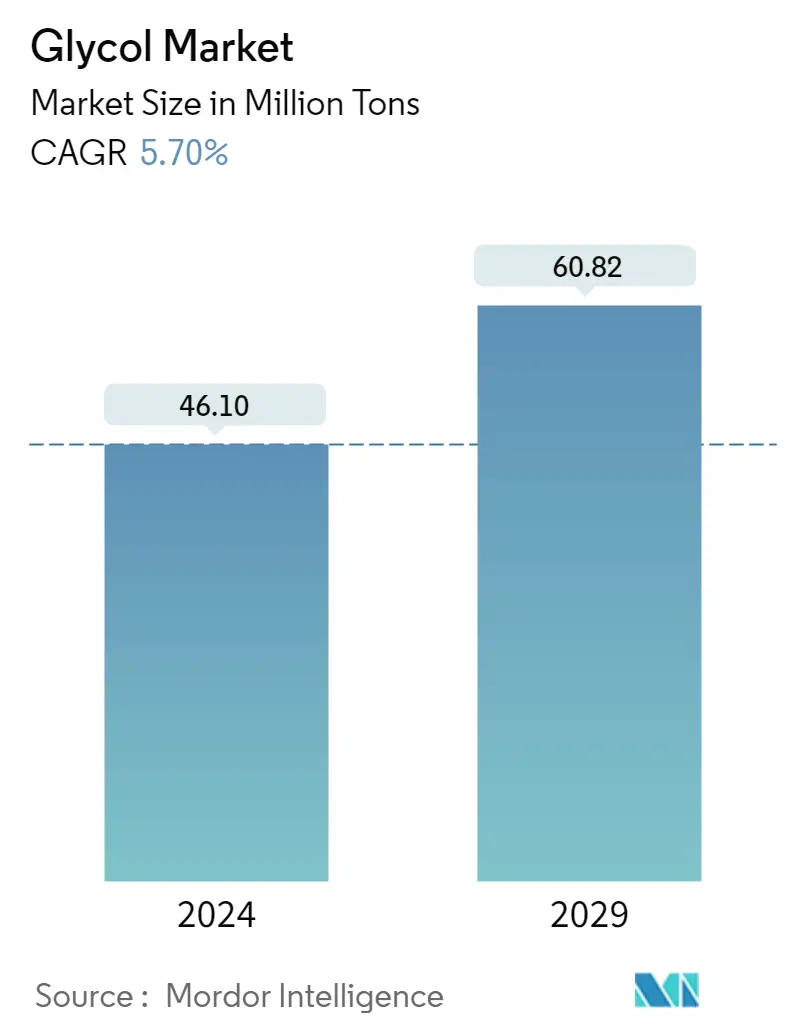
| Study Period | 2019 - 2029 |
| Base Year For Estimation | 2023 |
| CAGR (2024 - 2029) | 5.70 % |
| Fastest Growing Market | Asia Pacific |
| Largest Market | Asia Pacific |
| Market Concentration | Low |
Major Players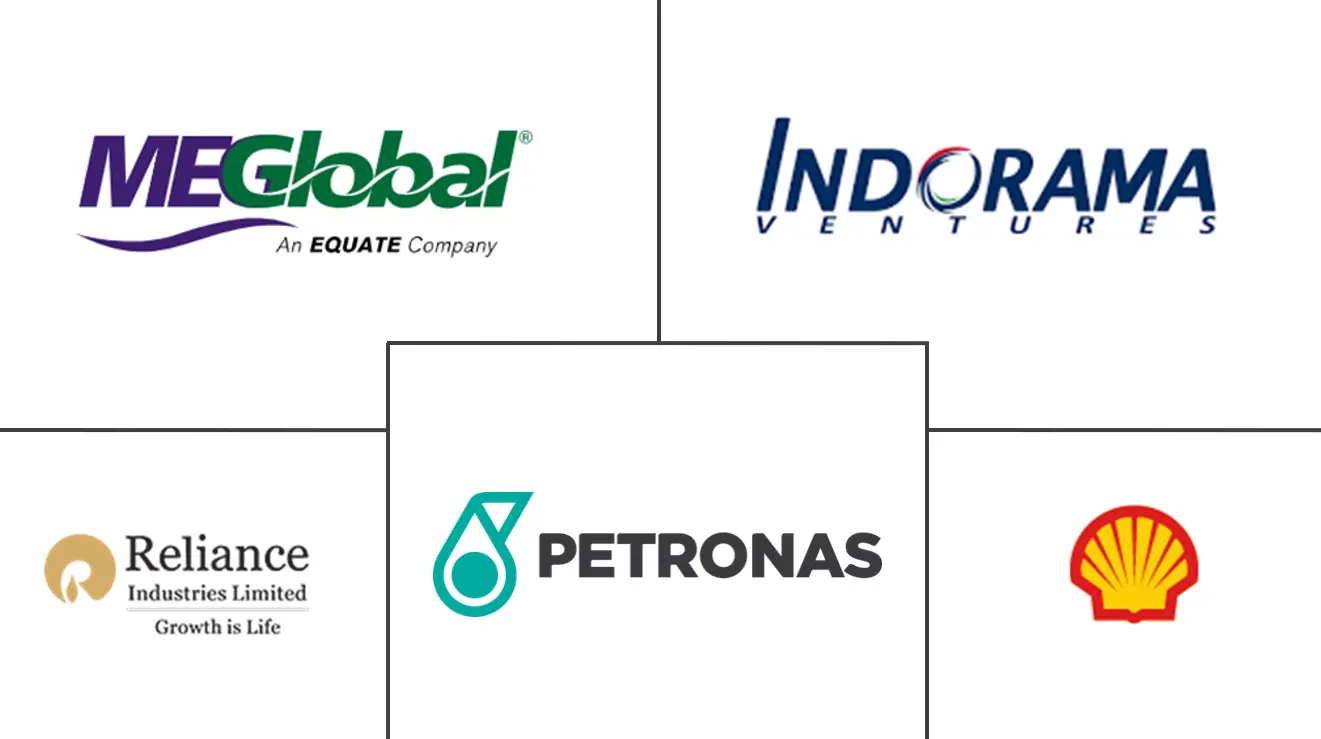
*Disclaimer: Major Players sorted in no particular order |
Glycol Market Analysis
The Glycol Market size is estimated at 46.10 Million tons in 2024, and is expected to reach 60.82 Million tons by 2029, growing at a CAGR of 5.70% during the forecast period (2024-2029).
.
- The COVID-19 pandemic has been a significant challenge for the glycol market due to directly affecting the manufacturer's supply chain across the globe and shutting down production facilities to minimize the risk of spreading the virus.
- Over the short term, increasing demand for polyester films and PU adhesives and increasing ethylene glycol consumption from china's textile industry are some factors stimulating the market demand.
- The toxic ethylene glycol and unfavorable conditions from the COVID-19 outbreak hinder the market growth.
- The growing popularity of bio-based glycols will likely create opportunities for the market in the coming years.
- The Asia-Pacific region represents the largest market and is expected to be the fastest-growing market over the forecast period owing to the increasing consumption from countries such as China, India, and Japan.
Glycol Market Trends
Increasing Usage in the Textile Industry
- Propylene glycol and ethylene glycol are used as raw materials in producing a wide range of products, including polyester fibers for clothes, upholstery, carpet, and pillows.
- The most valued applications of ethylene glycol are polyester fibers, widely used in textile industries. Glycol ethers are used as dyebath additives within the textile dyebath market to obtain properties such as proper shade, level dyeing, colorfastness, reduced dyeing temperatures, and cycle times.
- China, the European Union, and India are among the three largest exporters of textiles, holding a share of over 65% across the global market. For instance, in 2022, China exported textiles, apparel, and clothing accessories worth USD 323.344 billion, registering a slight growth of 2.53% compared to the previous year (2021). Therefore, increased export of textiles, apparel, and clothing accessories from the country is expected to create an upside demand for the glycol market.
- The Indian textile industry is one of the fastest-growing industries across the globe. According to India Brand Equity Foundation (IBEF), textile and apparel exports in India amounted to USD 44.4 billion in 2022, which shows an increase of 41% compared to 2021 and 26% compared to 2020. In 2022, the United States was the top export destination, accounting for 27% of textile exports, followed by Europe (18%) and Bangladesh (12%). Therefore, increased export of textile and apparel accessories from the country is expected to create an upside demand for the glycol market in the country.
- Moreover, in the first half of 2022, the United States' exports of textiles and clothing increased by 13.10% from the previous year. Compared to the same period in 2021, exports increased to USD 12.44 billion from January through June 2022 from USD 10.99 billion, according to data from the Office of Textiles and Apparel, a US Department of Commerce division.
- Furthermore, in October 2022, Prada, a high-end fashion brand, recently opened a factory near Sibiu, Romania. In the new factory, Prada will manufacture parts of its leather products. Hipic Prod Impex, now part of the Prada group, operates the factory in Sibiu's West Industrial Zone, measuring 31,000 sq ft. Therefore, this expansion is expected to create an upside demand for the glycol market.
- Based on all these factors, the glycol market will likely grow globally during the forecast period.
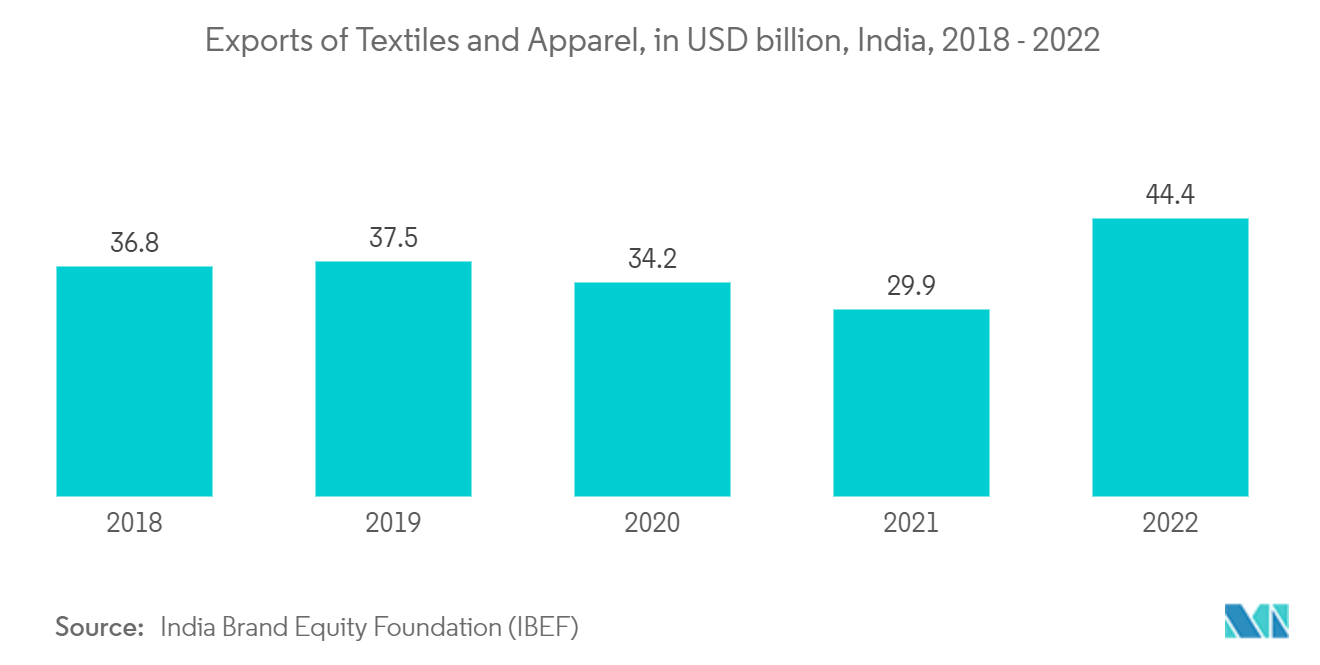
Asia-Pacific Region to Dominate the Market
- Asia-Pacific is expected to dominate the market for glycol consumption. It is also likely to be the fastest-growing market during the forecast period, with increasing demand from end-user industries such as packaging, food and beverage, automotive and transportation, cosmetics, textile, etc., in countries such as China, India, South Korea, Japan, and Southeast Asian nations.
- The demand from industries like food and beverage, consumer goods, and others for packing materials is increasing in the region owing to rising exports and domestic consumption. The packaging market in the Asia-Pacific region is driven by increasing demand for packaged foods and growing demand for fast-moving consumer goods, including E-commerce. The use of engineering plastic products in the packaging sector (PET containers, bottles, etc.) is increasing tremendously, owing to their advantages. PET is produced from ethylene glycol, dimethyl terephthalate (DMT), or terephthalic acid.
- For instance, according to India Brand Equity Foundation (IBEF), the Indian food processing industry grew rapidly, with an average annual growth rate of 8.3% in the past 5 years. Moreover, in 2023, the food market will generate USD 963 billion in revenue, which is anticipated to expand at a CAGR of 7.23% between 2023-2027. Therefore, this is expected to create an upside demand for the glycol market from food packaging.
- Moreover, ethylene glycol is used as an anti-freezing agent in the radiator of cars to increase the freezing temperature. For instance, according to OICA, in 2022, around 2,70,20,615 units of automobiles were produced in the country, which shows an increase of 3% compared with 2021. Therefore, an increase in the production of automobiles is expected to create an upside demand for the glycol market.
- China's E-commerce market is dominated by Alibaba, whose market share is around 44%. The company's annual revenue in FY 2022 saw a 22.91% year-on-year growth. The growing e-commerce industry requires packaging, which is expected to drive the glycol market in the region during the forecast period.
- The Asia-Pacific food additive market is expected to register a CAGR of about 6% during the forecast period. Propylene glycol is one of the most common glycols used as a food additive.
- The Asian cosmetics market is gaining popularity worldwide. It is expected to witness a CAGR of more than 5% during the forecast period. Japan, Singapore, South Korea, Hong Kong, and China are the top 10 global cosmetics exporters. Propylene glycol is used in moisturizers to enhance the appearance of skin by reducing flaking and restoring suppleness. Other uses include as a skin-conditioning agent, viscosity-decreasing agent, solvent, and fragrance ingredient.
- According to the National Bureau of Statistics of China, in January 2022, the retail trade revenue of cosmetics in China amounted to about USD 9.18 billion. It reached about USD 9.76 billion in January 2023. As the demand for cosmetic products expands further in second-and third-tier cities of China, the glycol market is expected to maintain its growth momentum soon. In addition, the changing attitude among men toward skin care fosters the booming men's cosmetics market in China.
- According to the India Brand Equity Foundation, India's domestic pharmaceutical market will likely reach USD 65 billion by 2024 and expand to USD 120- USD 130 billion by 2030. Moreover, India is a significant and rising player in the global pharmaceuticals sector. India is the world's largest supplier of generic medications, accounting for 20% of the worldwide supply by volume and supplying about 60% of the global vaccination demand. Therefore, the demand for the glycol market is expected to include an upside from the country's pharmaceutical market.
- Thus, rising demands from the end-user mentioned above industries are expected to drive growth in the Asia-Pacific region.
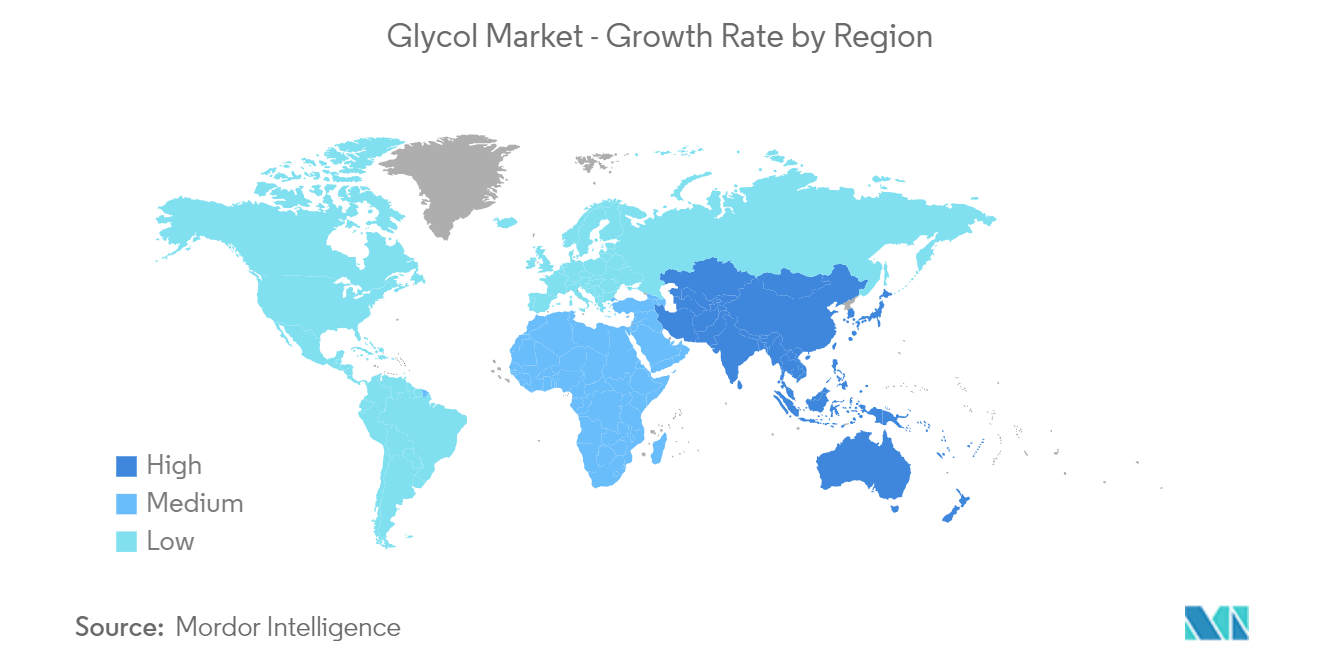
Glycol Industry Overview
The Glycol Market is fragmented in nature. Some of the major players in the market (not in a particular order) include Shell PLC, MEGlobal International FZE, Indorama Ventures Public Company Limited, Reliance Industries Limited, and PETRONAS Chemicals Group, among others.
Glycol Market Leaders
-
Shell PLC
-
MEGlobal International FZE
-
Indorama Ventures Public Company Limited
-
Reliance Industries Limited
-
PETRONAS Chemicals Group
*Disclaimer: Major Players sorted in no particular order
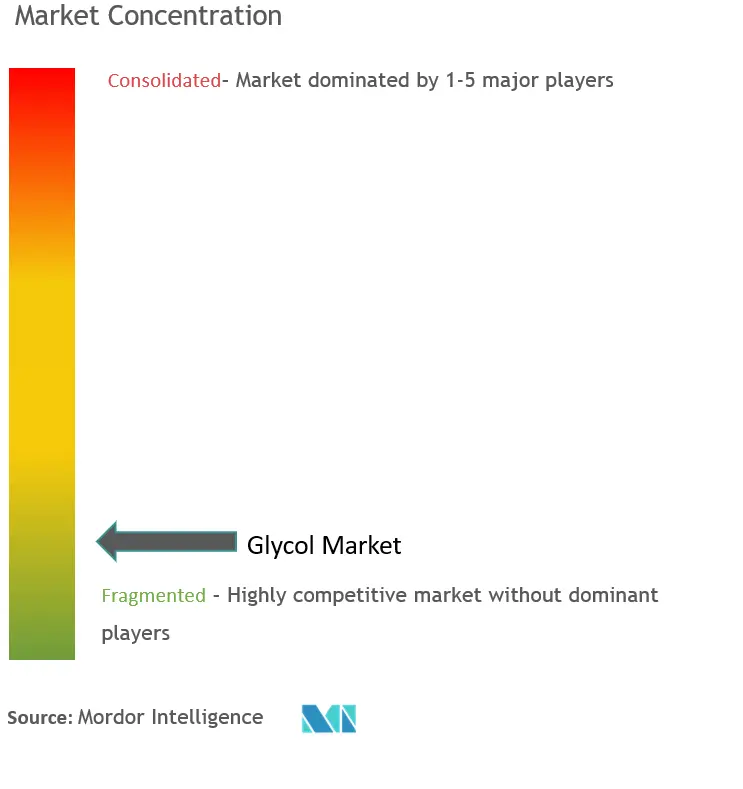
Glycol Market News
- October 2022: The Ministry of Environment, Forests, and Climate Change panel nodded to Reliance Industries Ltd's Hazira manufacturing complex's INR 100 billion (USD 1.33 billion) expansion and debottlenecking. The HMD complex of Mukesh Ambani's RIL was commissioned in 1991-92 to manufacture MonoEthylene Glycol, Vinyl Chloride Monomer (VCM), and others, along with utilities.
Glycol Market Report - Table of Contents
1. Introduction
- 1.1 Study Assumptions and Market Definition
- 1.2 Scope of the Study
2. Research Methodology
3. Executive Summary
4. Market Dynamics
-
4.1 Drivers
- 4.1.1 Increasing Demand for Polyester Films and PU Adhesives
- 4.1.2 Increasing Ethylene Glycol Consumption From China's Textile Industry
- 4.1.3 Other Drivers
-
4.2 Restraints
- 4.2.1 Toxic Nature of Ethylene Glycol
- 4.2.2 Other Restraints
- 4.3 Industry Value Chain Analysis
-
4.4 Porter's Five Forces Analysis
- 4.4.1 Bargaining Power of Suppliers
- 4.4.2 Bargaining power of Buyers
- 4.4.3 Threat of New Entrants
- 4.4.4 Threat of Substitute Products and Services
- 4.4.5 Degree of Competition
5. Market Segmentation (Market Size in Volume)
-
5.1 Type
- 5.1.1 Ethylene Glycol
- 5.1.1.1 Monoethylene Glycol (MEG)
- 5.1.1.2 Diethylene Glycol (DEG)
- 5.1.1.3 Triethylene Glycol (TEG)
- 5.1.1.4 Polyethylene Glycol (PEG)
- 5.1.2 Propylene Glycol
- 5.1.3 Other Types
-
5.2 End-user Industry
- 5.2.1 Automotive and Transportation
- 5.2.2 Packaging
- 5.2.3 Food and Beverage
- 5.2.4 Cosmetics
- 5.2.5 Pharmaceuticals
- 5.2.6 Textile
- 5.2.7 Other End-user Industries
-
5.3 Geography
- 5.3.1 Asia-Pacific
- 5.3.1.1 China
- 5.3.1.2 India
- 5.3.1.3 Japan
- 5.3.1.4 South Korea
- 5.3.1.5 Rest of Asia-Pacific
- 5.3.2 North America
- 5.3.2.1 United States
- 5.3.2.2 Canada
- 5.3.2.3 Mexico
- 5.3.3 Europe
- 5.3.3.1 Germany
- 5.3.3.2 United Kingdom
- 5.3.3.3 Italy
- 5.3.3.4 France
- 5.3.3.5 Rest of Europe
- 5.3.4 South America
- 5.3.4.1 Brazil
- 5.3.4.2 Argentina
- 5.3.4.3 Rest of South America
- 5.3.5 Middle-East and Africa
- 5.3.5.1 Saudi Arabia
- 5.3.5.2 South Africa
- 5.3.5.3 Rest of Middle-East and Africa
6. Competitive Landscape
- 6.1 Mergers and Acquisitions, Joint Ventures, Collaborations, and Agreements
- 6.2 Market Share(%)**/Ranking Analysis
- 6.3 Strategies Adopted by Leading Players
-
6.4 Company Profiles
- 6.4.1 BASF SE
- 6.4.2 China Petrochemical Corporation
- 6.4.3 China Sanjiang Fine Chemical Co Ltd
- 6.4.4 Dow
- 6.4.5 Huntsman International LLC
- 6.4.6 India Glycols Limited
- 6.4.7 Indian Oil Corporation Ltd
- 6.4.8 Indorama Ventures Public Company Limited
- 6.4.9 INEOS
- 6.4.10 LOTTE Chemical Corporation
- 6.4.11 LyondellBasell Industries Holdings B.V.
- 6.4.12 Meglobal International FZE
- 6.4.13 Mitsubishi Chemical Group Corporation
- 6.4.14 Nouryon
- 6.4.15 PETRONAS Chemicals Group
- 6.4.16 Petrorabigh
- 6.4.17 Reliance Industries Limited
- 6.4.18 SABIC
- 6.4.19 Shell PLC
- *List Not Exhaustive
7. Market Opportunities and Future Trends
- 7.1 Growing Popularity of Bio-based Glycols
- 7.2 Other Opportunities
Glycol Industry Segmentation
Glycol is a class of chemical compounds in the alcohol family. Two hydroxyl (OH) groups are bonded to distinct carbon atoms in the glycol molecules. The word is frequently applied to the simplest member of the class, ethylene glycol. The glycol is a colorless, odorless, flammable, sweet-tasting viscous liquid. It can be toxic to humans if taken in high concentrations. The glycol market is segmented based on type, end-user industry, and geography. By type, the market is segmented into ethylene glycol, propylene glycol, and other types. The end-user industry segments the market into automotive and transportation, packaging, food and beverage, cosmetics, pharmaceuticals, textiles, and other industries. The report also covers the market sizes and forecasts for the glycol market in 15 countries across major regions. Market sizing and forecasts for each segment are based on revenue (USD million) for all the above segments.
| Type | Ethylene Glycol | Monoethylene Glycol (MEG) |
| Diethylene Glycol (DEG) | ||
| Triethylene Glycol (TEG) | ||
| Polyethylene Glycol (PEG) | ||
| Type | Propylene Glycol | |
| Other Types | ||
| End-user Industry | Automotive and Transportation | |
| Packaging | ||
| Food and Beverage | ||
| Cosmetics | ||
| Pharmaceuticals | ||
| Textile | ||
| Other End-user Industries | ||
| Geography | Asia-Pacific | China |
| India | ||
| Japan | ||
| South Korea | ||
| Rest of Asia-Pacific | ||
| Geography | North America | United States |
| Canada | ||
| Mexico | ||
| Geography | Europe | Germany |
| United Kingdom | ||
| Italy | ||
| France | ||
| Rest of Europe | ||
| Geography | South America | Brazil |
| Argentina | ||
| Rest of South America | ||
| Geography | Middle-East and Africa | Saudi Arabia |
| South Africa | ||
| Rest of Middle-East and Africa |
Glycol Market Research FAQs
How big is the Glycol Market?
The Glycol Market size is expected to reach 46.10 million tons in 2024 and grow at a CAGR of 5.70% to reach 60.82 million tons by 2029.
What is the current Glycol Market size?
In 2024, the Glycol Market size is expected to reach 46.10 million tons.
Who are the key players in Glycol Market?
Shell PLC, MEGlobal International FZE, Indorama Ventures Public Company Limited, Reliance Industries Limited and PETRONAS Chemicals Group are the major companies operating in the Glycol Market.
Which is the fastest growing region in Glycol Market?
Asia Pacific is estimated to grow at the highest CAGR over the forecast period (2024-2029).
Which region has the biggest share in Glycol Market?
In 2024, the Asia Pacific accounts for the largest market share in Glycol Market.
What years does this Glycol Market cover, and what was the market size in 2023?
In 2023, the Glycol Market size was estimated at 43.61 million tons. The report covers the Glycol Market historical market size for years: 2019, 2020, 2021, 2022 and 2023. The report also forecasts the Glycol Market size for years: 2024, 2025, 2026, 2027, 2028 and 2029.
Glycol Industry Report
The Glycol Market report provides a comprehensive industry analysis, covering various types of glycol such as ethylene glycol (including Monoethylene Glycol, Diethylene Glycol, Triethylene Glycol, and Polyethylene Glycol), propylene glycol, and other types. The report delves into the market segmentation by end-user industries, which include automotive and transportation, packaging, food and beverage, cosmetics, pharmaceuticals, textile, and other end-user industries. The analysis spans across different geographical regions, including Asia-Pacific, North America, Europe, South America, and the Middle-East and Africa.
The industry outlook indicates a positive market growth, supported by detailed industry statistics and trends. The market forecast provides insights into future market growth and value, helping stakeholders understand the market size and segmentation. The report also includes industry research and market data, offering an in-depth market overview and review.
Key industry reports and market reports are available as a sample in a report PDF, which includes a market cap and price trends analysis. The market outlook and predictions highlight the potential growth rate and market leaders, providing valuable industry information and research companies' insights.
Overall, this report example serves as a vital resource for understanding the glycol market, offering a detailed industry analysis, market forecast, and industry trends. The report covers all necessary aspects, from market segmentation and value to industry sales and growth rate, making it an essential tool for market research and strategic planning.



